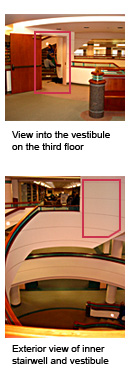COOL AT THE TOP - ECS CASE STUDY 2007
![]()

| Introduction |
|
Knight Library was originally designed by Ellis F. Lawrence and constructed in 1937. Since 1937 the library has undergone three major renovations and expansions, the most recent being completed in 1994. The overarching goal of this final renovation was to integrate the once existing three buildings into one functioning whole, the largest component being the South Lawn addition adding 85,505 sq ft. Renovations included updates to the HVAC system and incorporated a number of passive and active design features for which the building has won a few awards. The energy efficiency of the building is said to reduce energy consumption by 31%* according to the University of Oregon. While searching for items to study or employees to speak with about possible topics, we were walking through the Knight Library and stumbled upon the south stairwell. Crossing through the threshold to the stair that leads from third to the fourth floor, we were blasted with a sudden burst of wind. In reaction, we became interested in determining the existence of this air movement and its velocity. ASHRAE states that 40 fpm or less is anacceptable level of air movement without effecting the comfort zone. Based upon our own personal judgment, the level of air movement felt uncomfortable and would be considered an annoyance if present in the space for any period of time. Consequently, our research revolved around determining if this wind was greater than 40 fpm. By measuring air speed at this specific location of the Knight Library, we were able to determine the presence of wind on every day we tested, all at different times of day. The observation of air movement and temperature through the remainder of the circular stair, and the stair’s adjoining spaces on each floor was documented in order to look for statistical correlation that may be a cause of this air movement.
**http://libweb.uoregon.edu/knight/expansion.htm
|